|
|
|
|
|
|
|
Achi-Kochi Japan
Showing many places to visit and foods to eat in Japan
|
|
|
|
|
|
|
|
|
|
|
|
|
Japan
> Tokyo region
> Ueno
|
|
|
|
|
|
|
Ueno
Tokyo ( Achi-Kochi Japan )
|
|
|
|
|
|
|
|
|
|
|
|
|
( "Achi-Kochi" in Japanese means "Here and there" in English. )
|
Hanami ( Sakura Viewing ) in Ueno
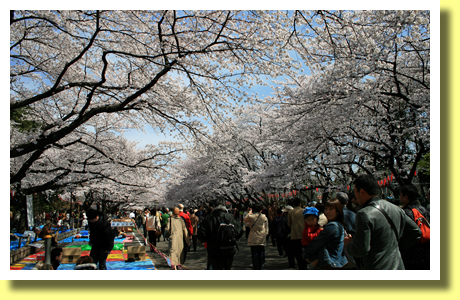
Ueno Park in Tokyo may not be the best place in Japan to enjoy Hanami ( Sakura Viewing - above ) but could be the most famous and popular for Hanami. Actually too many people visit Ueno Park to see Sakura ( Cherry Blossoms ) in spring ( end March - early April averagely ).
"Hana" in Japanese means "Blossoms and/or Flowers" while "Mi" means "Viewing". It is said that the traditional custom of Hanami in Japan started in the 8th century. However Hanami at the time means not Sakura ( Cherry Blossoms ) Viewing but Ume ( Plum Blossoms ) Viewing. The meaning of "Hanami" changed probably in the 9th-11th century.
In A.D.1625 Kan'ei-ji temple was founded and lots of cherry trees were planted in and around the temple. So Ueno became famous for Sakura in the 17th century and Ueno Park was establised in A.D.1873 as the 1st public park in Japan. It is said that there are about eight hundred cherry trees in the park.
|
|
Shinobazu-no-Ike ( pond )

Shinobazu-no-Ike ( pond - above ) is my most favorite place in Ueno Park to enjoy Hanami ( Sakura Viewing ). Its circumference is about 2km and it is fun to walk around the pond especially in Sakura season. Rental boats could be entertaining.
|
|
Kan'ei-ji Temple
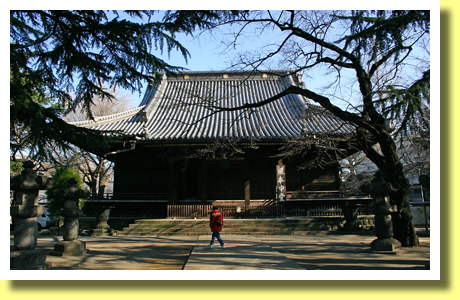
Kan'ei-ji ( above ) is a temple located in Ueno Park. Most of the site of Ueno Park, including Shinobazu-no-Ike, used to belong to the temple. Kan'ei-ji was founded in A.D.1625 by a Buddhist monk Tenkai, who was an influential aide to Ieyasu Tokugawa, who established Tokugawa Shogunate in A.D.1603.
Hidetada Tokugawa, the 2nd shogun and Iemitsu Tokugawa, the 3rd shogun trusted Tenkai as well. So they helped Tenkai found Kan'ei-ji and the extensive site and tens of structures belonged to the temple.
In A.D.1657, many buildings of the temple were burnt down in the Meireki fire, which destroyed the main keep of Edo-jo Castle as well. However the structures of the temple, one of the graveyards of Tokugawa shoguns, were reconstructed in the following decades.
|
|
Battle of Ueno

In A.D.1868 when Tokugawa Shogunate was overthrown and Yoshinobu Tokugawa, the 15th and last shogun, surrendered Edo-jo Castle and confined himself in Mito. However some of Tokugawa retainers and supperters occupied Kan'ei-ji and fought against forces of Meiji Government. So most of the structures of the temple were destroyed in Battle of Ueno ( above ). Very few buildings were reconstructed.
|
|
Ueno Toshogu
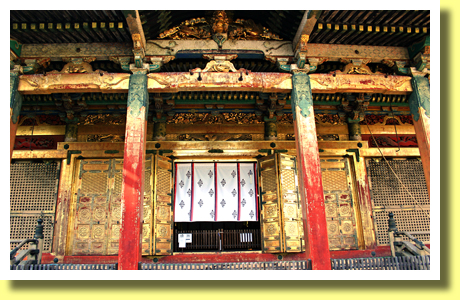
Ueno Toshogu ( shrine - above ) in Ueno Park is popular as well. The shrine was founded in A.D.1627 to enshrine Ieyasu Tokugawa, who established Tokugawa Shogunate. In A.D.1651 some structures were rebuilt by Iemitsu Tokugawa who is a grandson of Ieyasu and the 3rd shogun and who renovated Nikko Toshogu.
The buildings of the shrine survived the fire in A.D.1657, Battle of Ueno in A.D.1868, the Great Kanto earthquake in A.D.1923 and WWII. In the shrine there are some structures designated Important Cultural Properties of Japan.
|
|
Tokyo National Museum

There are some museums and some art museums in Ueno Park. Among them, the Tokyo National Museum could be recommended. The museum, established in A.D.1872, holds and houses lots of properties including more than a hundred National Treasures and hundreds of Important Cultural Properties of Japan. Visiting the museum would be the most efficient way to know the history, culture and art of Japan.
|
|
Hanami in the 17th century
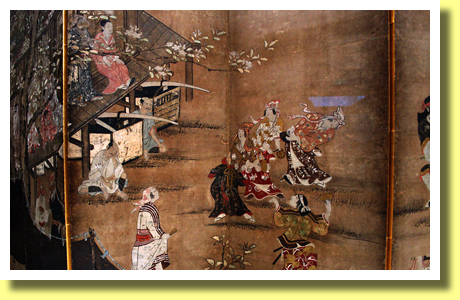
The above, a part of picture painted on a folding screen in the 17th century, shows Hanami. The picture is titled "Merrymaking Under The Cherry Blossoms". It seemes that Japanese people liked Hanami in the 17th century. The picture is one of the designated National Tresures of Japan, held in Tokyo National Museum.
|
|
Hanami in the 19th century

The above, a picture painted in the 19th century by Hiroshige Utagawa,
held in Tokyo National Museum, aslo shows Hanami at Asukayama, where lots of cherry trees were planted by the 8th shogun Yoshimune Tokugawa in the 18th century. Asukayama, located to the north of Ueno, has been and is one of the sites famous for Hanami as well.
|
|
Dogu
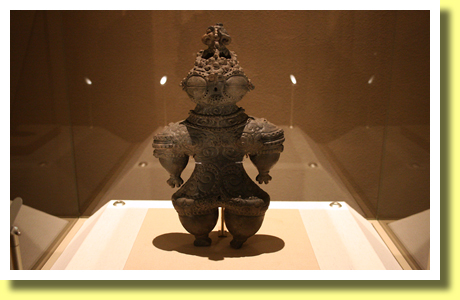
The above is a Dogu exhibited in the Tokyo National Museum. The Dogu, a figurine made in B.C.1000-400 in Japan, is one of the Shakoki-dogu ( goggle-eyed dogu ). Almost 15,000 dogu have been found in Japan. The above is one of the very few figurines found unbroken. ( ==> A History of Japan vol.1 Formation of Japan )
|
|
Tea Ceremony

In the site of the Tokyo National Museum, there are some old Japanese Houses where traditional Japanese tea ceremonies are held occasionally. The above shows a tea ceremony held in Okyo-kan, which was built in A.D.1742 and moved to the site in A.D.1933.
Some of tea ceremonies in Okyo-kan are open to the public. It could be a good experience of visitors'.
|
Copyright (c) 2021 Achi-Kochi Zanmai Co., Ltd.
|